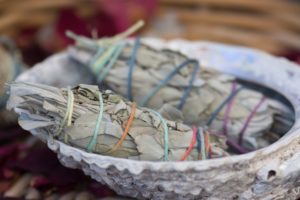
Sage smudging is used for a wide variety of purposes by people following traditional Indigenous spiritual paths as well as New Age, Neopagan and various shamanic belief systems. To fully understand this practice, it’s worth examining its cultural and spiritual roots. While seeking to understand these rituals, questions about its use by non-Native people and cultural appropriation also arise.
The Basics of Smudging
Simply put, smudging involves the burning of herbs or other kinds of plant matter. The botanicals that are considered sacred can vary with each Indigenous culture, but a short list of plants collected and used for this purpose includes the following:
- Common sage
- White sage
- Red cedar
- Tobacco
- Sweet grass
- Copal tree resin
It’s important to remember that not all Native cultures consider the same plants sacred, nor do they follow the same processes for gathering, preparation, and burning. Also, the reasons for their ceremonial uses vary. Contemporary spiritual practices mostly focus on smudging to purify or hallow a space, but the Dancing to Eagle Spirit Society documents its usage to help a person obtain spiritual visions or heal illnesses.
Common and White Sage Varieties
Many modern smudging traditions adopted by non-Indigenous people usually involve either common or white sage. The former is a plant native to the Mediterranean, prized for its flavor and scent but also viewed as possessing healing properties. It’s no surprise that it was a ubiquitous ingredient in kitchens, apothecaries, and temples around Europe and the Middle East. However, white sage only grows in the southwestern United States and parts of northwestern Mexico. Consequently, the herb goes by a wide variety of names in several Native languages spoken in the region.
Debates Over Cultural Appropriation
While some writers and online vendors claim that the tradition dates to ancient Greece, most contemporary practitioners draw inspiration from Indigenous traditions. Finding a “smudging kit” is as easy as typing the words into your search engine of choice, with hundreds of retailers offering their wares. Some blanketly state that sage smudging is a “Native American custom” without distinguishing how it was observed within individual civilizations.
Meanwhile, its inclusion into New Age, Western shamanic, and Neopagan spiritual practices has drawn criticism from Indigenous people. In some cases, it’s been compared with other culturally appropriative acts such as wearing Native headdresses or claiming to have a “spirit animal.” In a 2017 Seeding Sovereignty blog post, Canadian First Nations activist Christine Nobiss refers to “plastic shamanism,” a term coined by scholar Lisa Aldred to describe the commercialization of Indigenous spiritual and cultural customs. Nobiss critiques some merchants and non-Native practitioners, calling the coopting of these traditions and artifacts exploitative while distorting and diluting their original meaning.
Nobiss’s point may be especially salient, considering that Native people have been frequently prevented from practicing their religious beliefs by laws such as Canada’s Indian Act of 1884 and United States regulations banning sweat lodges and sun dance ceremonies. Moreover, use by non-Indigenous people may have resulted in unintended ecological impacts. An August 2013 Ecolutionist article reveals that the wild white sage is now endangered, partially due to overharvest to meet high market demands. While it’s not going extinct, free access to the plant has been limited, posing additional problems for Native people relying on it for ceremonial and other purposes.
Responsible Spiritual Practices
Many religious and cultural practices involving smudging varied between civilizations and were orally transmitted from generation to generation. As debates and discussion about smudging and cultural appropriation continue alongside ecological concerns about the scarcity of white sage, acknowledging the roots of these customs and selecting one’s materials wisely is key. While the choice to smudge is ultimately an individual one, a sensitive approach can avoid offense and causing environmental harm.

